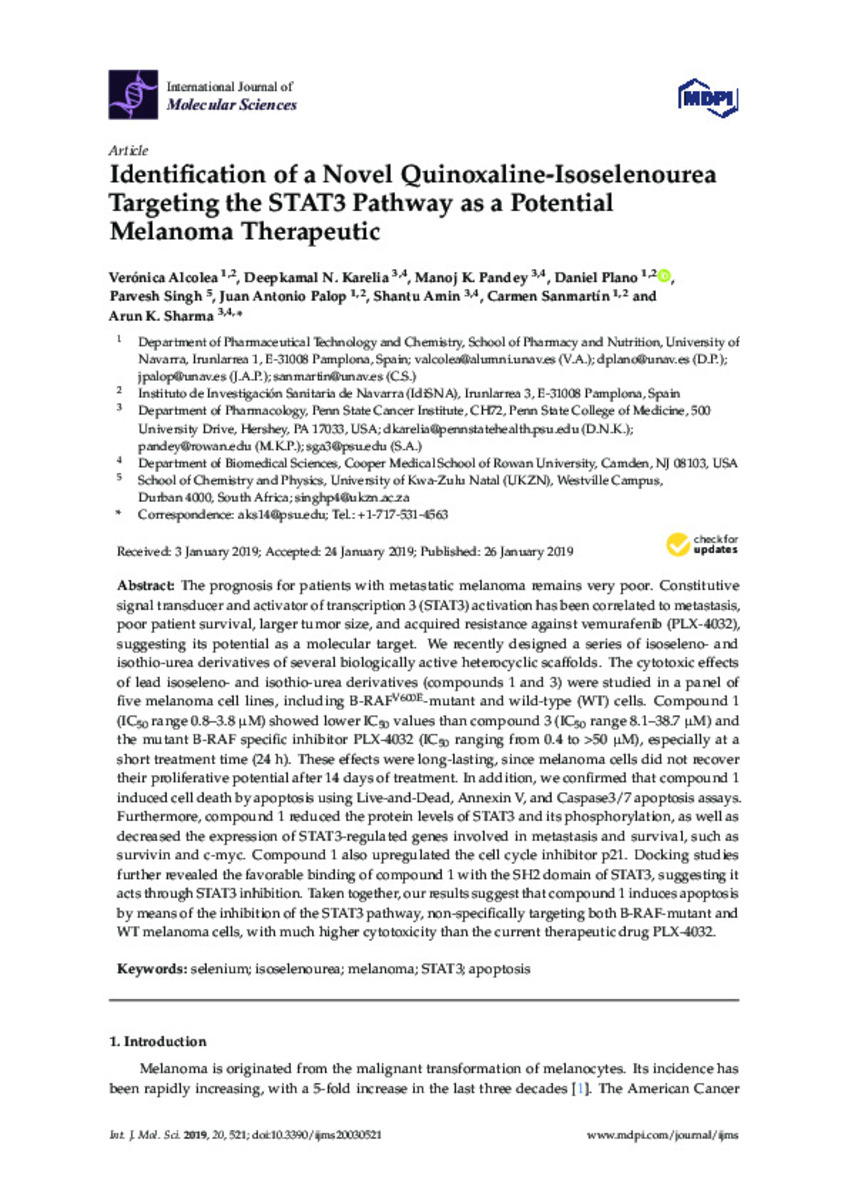Registro completo de metadatos
| Campo DC | Valor | Lengua/Idioma |
|---|---|---|
| dc.creator | Alcolea-Devesa, V. (Verónica) | - |
| dc.creator | Karelia, D.N. (Deepkamal N.) | - |
| dc.creator | Pandey, M.K. (Manoj K.) | - |
| dc.creator | Plano-Amatriain, D. (Daniel) | - |
| dc.creator | Singh, P. (Parvesh) | - |
| dc.creator | Palop-Cubillo, J.A. (Juan Antonio) | - |
| dc.creator | Amin, S. (Shantu) | - |
| dc.creator | Sanmartin-Grijalba, C. (Carmen) | - |
| dc.creator | Sharma, A.K. (Arun K.) | - |
| dc.date.accessioned | 2022-03-02T08:41:04Z | - |
| dc.date.available | 2022-03-02T08:41:04Z | - |
| dc.date.issued | 2019 | - |
| dc.identifier.citation | Alcolea-Devesa, V. (Verónica); Karelia, D.N. (Deepkamal N.); Pandey, M.K. (Manoj K.); et al. "Identification of a novel quinoxaline-isoselenourea targeting the STAT3 pathway as a potential melanoma therapeutic". International Journal of Molecular Sciences. 20 (3), 2019, 521 | es |
| dc.identifier.issn | 1422-0067 | - |
| dc.identifier.uri | https://hdl.handle.net/10171/62969 | - |
| dc.description.abstract | The prognosis for patients with metastatic melanoma remains very poor. Constitutive signal transducer and activator of transcription 3 (STAT3) activation has been correlated to metastasis, poor patient survival, larger tumor size, and acquired resistance against vemurafenib (PLX-4032), suggesting its potential as a molecular target. We recently designed a series of isoseleno- and isothio-urea derivatives of several biologically active heterocyclic scaffolds. The cytotoxic effects of lead isoseleno- and isothio-urea derivatives (compounds 1 and 3) were studied in a panel of five melanoma cell lines, including B-RAFV600E-mutant and wild-type (WT) cells. Compound 1 (IC50 range 0.8–3.8 µM) showed lower IC50 values than compound 3 (IC50 range 8.1–38.7 µM) and the mutant B-RAF specific inhibitor PLX-4032 (IC50 ranging from 0.4 to >50 µM), especially at a short treatment time (24 h). These effects were long-lasting, since melanoma cells did not recover their proliferative potential after 14 days of treatment. In addition, we confirmed that compound 1 induced cell death by apoptosis using Live-and-Dead, Annexin V, and Caspase3/7 apoptosis assays. Furthermore, compound 1 reduced the protein levels of STAT3 and its phosphorylation, as well as decreased the expression of STAT3-regulated genes involved in metastasis and survival, such as survivin and c-myc. Compound 1 also upregulated the cell cycle inhibitor p21. Docking studies further revealed the favorable binding of compound 1 with the SH2 domain of STAT3, suggesting it acts through STAT3 inhibition. Taken together, our results suggest that compound 1 induces apoptosis by means of the inhibition of the STAT3 pathway, non-specifically targeting both B-RAF-mutant and WT melanoma cells, with much higher cytotoxicity than the current therapeutic drug PLX-4032. | es_ES |
| dc.description.sponsorship | This research was funded by Caixa Foundation-UNED-Caja Navarra. | es_ES |
| dc.language.iso | eng | es_ES |
| dc.publisher | MDPI AG | es_ES |
| dc.rights | info:eu-repo/semantics/openAccess | es_ES |
| dc.subject | Selenium | es_ES |
| dc.subject | Isoselenourea | es_ES |
| dc.subject | Melanoma | es_ES |
| dc.subject | STAT3 | es_ES |
| dc.subject | Apoptosis | es_ES |
| dc.title | Identification of a novel quinoxaline-isoselenourea targeting the STAT3 pathway as a potential melanoma therapeutic | es_ES |
| dc.type | info:eu-repo/semantics/article | es_ES |
| dc.description.note | This article is an open access article distributed under the terms and conditions of the Creative Commons Attribution (CC BY) license (http://creativecommons.org/licenses/by/4.0/). | es_ES |
| dc.identifier.doi | 10.3390/ijms20030521 | - |
| dadun.citation.number | 3 | es_ES |
| dadun.citation.publicationName | International Journal of Molecular Sciences | es_ES |
| dadun.citation.startingPage | 521 | es_ES |
| dadun.citation.volume | 20 | es_ES |
Ficheros en este ítem:
Estadísticas e impacto
Los ítems de Dadun están protegidos por copyright, con todos los derechos reservados, a menos que se indique lo contrario.






